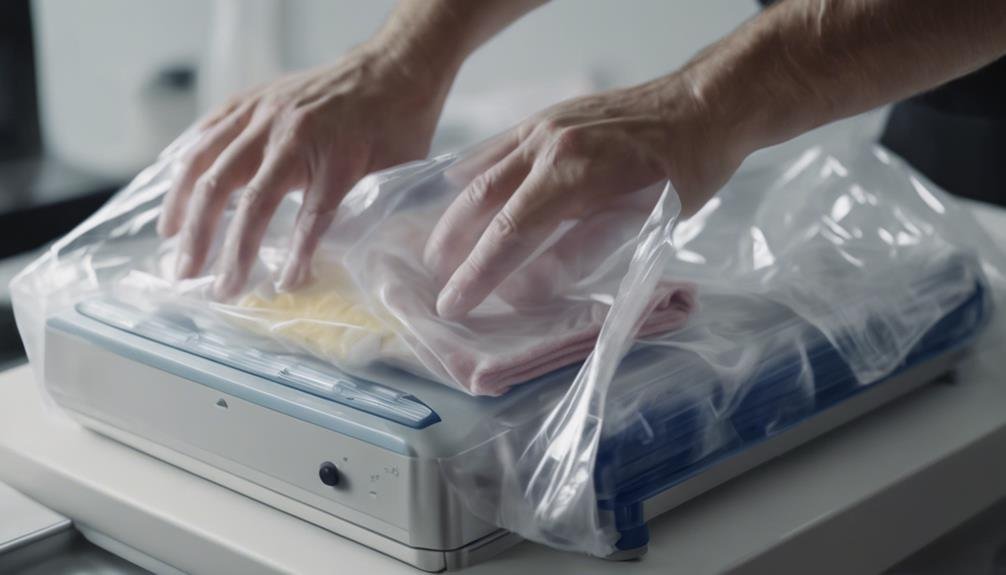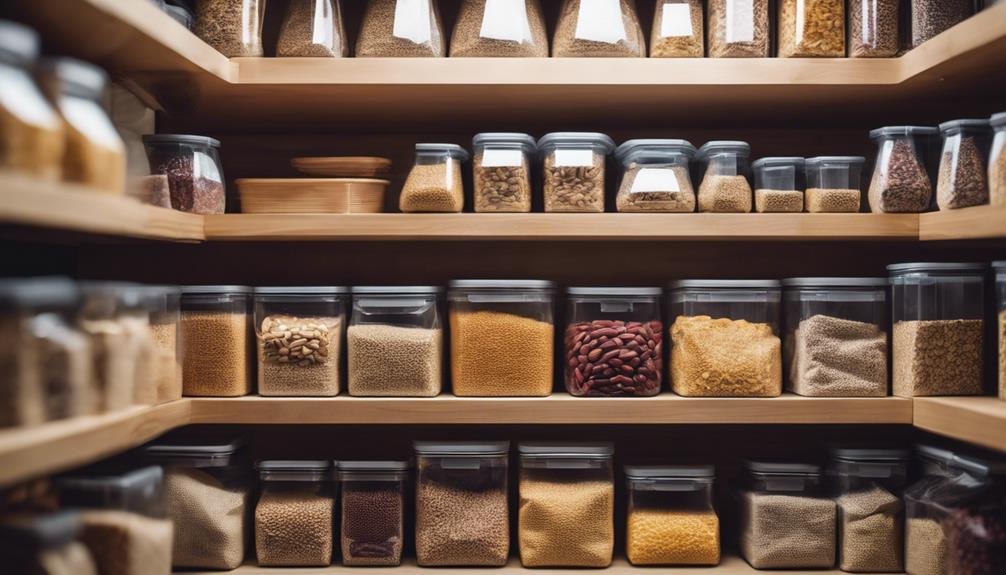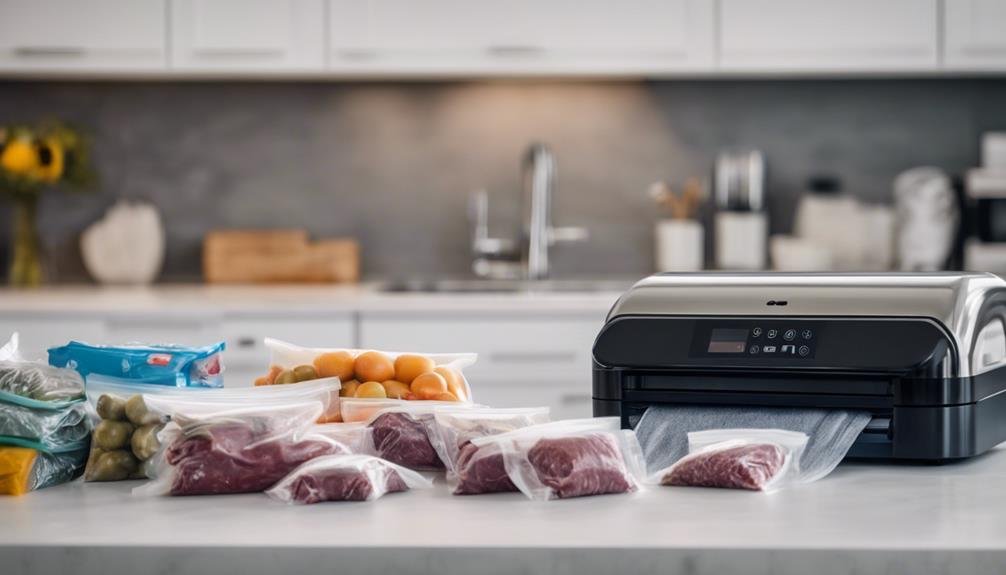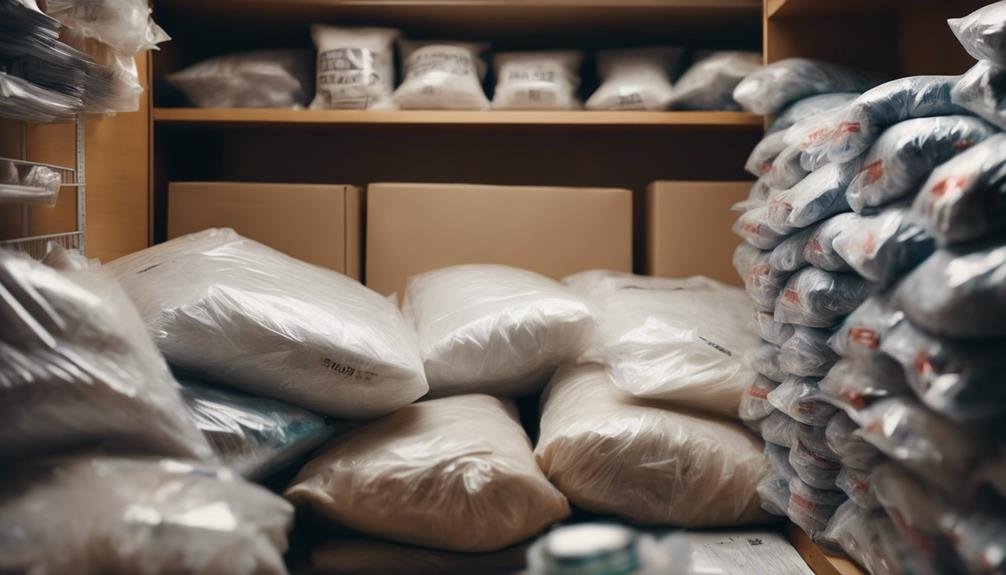Vacuum sealing is a game-changer for maximizing storage space in your kitchen. By removing air from food packaging, you can reduce storage requirements by up to 50%. This technique allows you to stack sealed bags efficiently, making the most of vertical space in your pantry, refrigerator, and freezer. You'll be able to organize food more effectively, improve visibility, and reduce clutter. Vacuum sealing not only saves space but also extends food freshness, prevents freezer burn, and reduces waste. It's particularly useful for small kitchens or when you need to store large quantities of food. With the right equipment and methods, you'll discover a world of space-saving possibilities.
Benefits of Vacuum Sealing
In addition to preserving food, vacuum sealing offers significant space-saving advantages for your kitchen storage. When you use this method, you'll find that it can reduce the space needed for storing items by up to 50% compared to traditional storage techniques.
This dramatic reduction in required space is a key benefit of vacuum sealing, allowing you to make the most of your available storage areas.
You'll appreciate how vacuum sealing enables efficient organization and stacking of food items in your fridge, freezer, or pantry. The airtight seal of vacuum bags eliminates air pockets, preventing food from taking up unnecessary space.
This feature is particularly valuable if you're dealing with a small kitchen or limited storage areas.
Space-Saving Techniques
Now that you understand the space-saving benefits of vacuum sealing, let's explore specific techniques to maximize your storage efficiency. Vacuum bags are your key to creating an airtight seal and revolutionizing your food storage. By using these bags, you'll reduce space usage by a whopping 50% compared to traditional methods. This means you can store twice as much in the same area!
To make the most of vacuum sealing, try these space-saving techniques:
- Stack your sealed bags: The compact design allows for easy stacking, both in your fridge and freezer.
- Organize by category: Group similar items together for quick access and efficient use of space.
- Use clear bags: This allows you to easily identify contents without unpacking.
- Maximize vertical space: Take advantage of the stackability to utilize every inch of your storage areas.
These techniques are especially useful if you have a small kitchen. You'll be amazed at how much more you can fit in your freezer and fridge. By efficiently organizing your vacuum-sealed items, you'll create a clutter-free environment that's both functional and space-saving. Embrace these methods, and you'll transform your food storage experience.
Proper Vacuum Sealing Methods

To maximize the space-saving benefits of vacuum sealing, you'll need to master proper sealing techniques. Start by choosing high-quality vacuum storage bags that fit your items snugly. When placing food or other items in the bag, make sure there's enough space around them for effective air removal.
Begin the sealing process by smoothing out any wrinkles in the bag, as these can create air pockets. Position the open end of the bag in your vacuum sealer, ensuring it's aligned correctly. Activate the machine to start removing the air from the bag. You'll notice the bag tightening around your items as the air is extracted.
Once the air is removed, the sealer will automatically create an airtight seal. Double-check that the seal is complete and free of any gaps or openings. For extra protection, you can create a second seal slightly above the first one.
When vacuum sealing delicate items, use the pulse function to control the air removal process gradually. This prevents crushing or damaging fragile contents.
Best Foods for Vacuum Sealing
While mastering proper sealing techniques is important, knowing which foods are best suited for vacuum sealing can help you maximize your storage space and food preservation efforts. Vacuum sealers are excellent tools for extending the shelf life of many foods by reducing their exposure to air. Bread, steak, and wine are ideal candidates for vacuum sealing, as they benefit greatly from this preservation method.
When using your vacuum sealer and FoodSaver bags and rolls, keep in mind that not all foods are suitable for this process. You'll want to avoid sealing soft cheese, bananas, and mushrooms, as they don't respond well to the vacuum environment. Instead, focus on foods that can withstand the pressure and maintain their quality.
Here are four tips to help you make the most of your vacuum sealing:
- Cool freshly cooked vegetables before sealing
- Use portion-sized bags for easier meal prep
- Double-seal items with high moisture content
- Label bags with contents and date for easy identification
Organizing Your Pantry

With vacuum sealing in your arsenal, you're ready to tackle pantry organization like a pro. This versatile method offers a game-changing solution for maximizing your storage space. By removing excess air from bags, vacuum sealing greatly reduces the bulk of food packaging, allowing you to make the most of your pantry shelves.
You'll find that vacuum-sealed bags are incredibly easy to stack and nest, thanks to their compact size. This efficient use of space means you can store more items without cluttering your pantry. Plus, you can label these bags and store them upright, improving visibility and accessibility of your stored goods.
Vacuum sealing is particularly effective for items like grains, nuts, and dried fruits. These foods, which typically take up considerable space, can now be compressed into neat, space-saving packages. You'll be amazed at how much room you'll free up on your shelves.
Not only does vacuum sealing help you organize your pantry more effectively, but it also extends the shelf life of your food. With a well-organized, vacuum-sealed pantry, you'll enjoy easier access to your items and reduced food waste.
Maximizing Freezer Capacity
Vacuum sealing doesn't just work wonders in your pantry—it's also a game-changer for maximizing your freezer's capacity. By removing excess air from food packages, you'll create flat, stackable bags that take up much less space than traditional storage methods. In fact, studies show that vacuum sealed food can occupy up to 50% less space, allowing you to store more items in your freezer without sacrificing organization or efficiency.
When you use a vacuum sealer for your frozen goods, you'll enjoy several benefits:
- More room for additional items
- Easier access to food due to improved organization
- Reduced freezer clutter and ice buildup
- Extended food freshness and quality
The compact nature of vacuum sealed bags means you can say goodbye to bulky containers and hello to a well-organized freezer. You'll be able to see and reach your frozen items more easily, making meal planning and preparation a breeze.
Plus, by removing air from the packages, you're not only saving space but also preserving food quality for longer periods.
Equipment for Vacuum Sealing

To get started with vacuum sealing, you'll need the right equipment for your specific storage needs and space constraints. Vacuum sealing machines come in two main types: countertop and handheld models. Countertop sealers are ideal if you have room to spare and plan on sealing larger quantities. Handheld units are perfect for those with limited space or who need portability.
When using a vacuum sealer, you'll want to make sure you have the proper bags and rolls. These allow you to customize your packaging, ensuring you're not wasting much space. Many machines feature built-in roll storage and cutter bars, streamlining the process and saving even more room.
Don't forget about additional accessories that can enhance your vacuum sealing experience. Jar sealers and bottle stoppers expand your options beyond just bags, allowing you to preserve a wider variety of items. These tools can help you maximize storage efficiency in your pantry, refrigerator, and freezer.
Long-Term Food Storage Solutions
Many long-term food storage solutions benefit from vacuum sealing's space-saving advantages. By removing excess air and creating an airtight seal, you'll greatly reduce the space needed for storing food items. This method can decrease your storage requirements by up to 50%, allowing you to maximize your freezer's capacity and organize your food more efficiently.
Vacuum sealing isn't just about saving space; it's also about preserving food quality. The airtight seal helps prevent freezer burn and slows down bacteria growth, ensuring your food stays fresh for longer periods. This means you can store more food for extended durations without worrying about spoilage.
Here are four ways vacuum sealing enhances long-term food storage:
- Compact stacking: Flattened, air-free packages are easier to stack and organize.
- Versatility: You can vacuum seal various foods, from meats to vegetables and even liquids.
- Portion control: Seal individual servings for easy meal planning and less waste.
- Extended shelf life: Properly sealed foods can last 3-5 times longer than traditional storage methods.
Cost-Effectiveness of Vacuum Sealing

While the initial investment in a vacuum sealer may seem steep, you'll quickly recoup the costs through reduced food waste and smarter shopping habits. Vacuum sealing greatly reduces the size of food packages, allowing you to maximize your storage space and organize your kitchen more efficiently.
Unlike traditional Zip-lock bags, vacuum-sealed packages take up to 50% less space, enabling you to store more food in the same area. This space-saving benefit allows you to buy in bulk, taking advantage of sales and discounts without worrying about where to store your purchases. By portioning and sealing larger quantities, you'll save money in the long run and reduce trips to the grocery store.
The vacuum sealing process removes air from inside the bag, preventing freezer burn and extending the shelf life of your food. This means you'll waste less food due to spoilage, saving you money over time.
Additionally, the compact nature of vacuum-sealed packages makes it easier to organize your refrigerator, freezer, and pantry, reducing the likelihood of forgotten items going to waste. By investing in a vacuum sealer, you're not just saving space – you're making a cost-effective choice for your household.
Conclusion
You've set off on a journey through the world of vacuum sealing, discovering its space-saving magic. Like a skilled magician compressing a large object into a tiny box, you've learned to shrink your food's footprint.
You're now equipped to transform your pantry and freezer into efficient, organized spaces. As you apply these techniques, imagine yourself as the captain of a well-stocked ship, ready to weather any storm with your perfectly preserved provisions.
